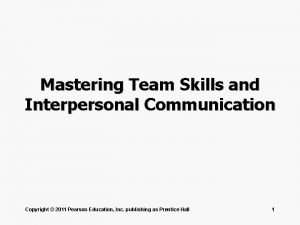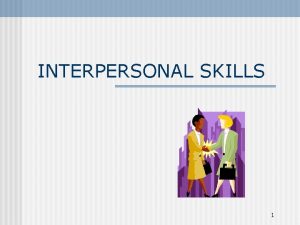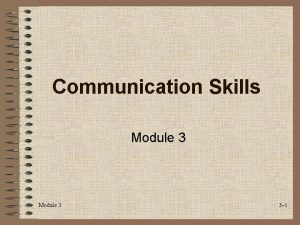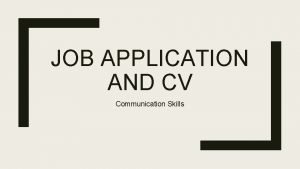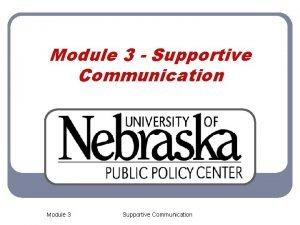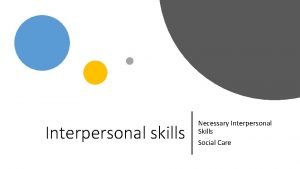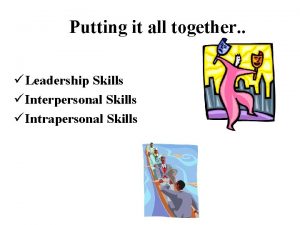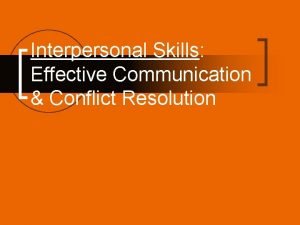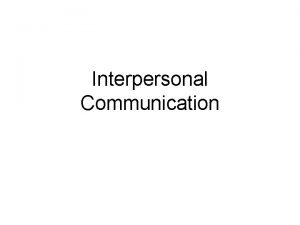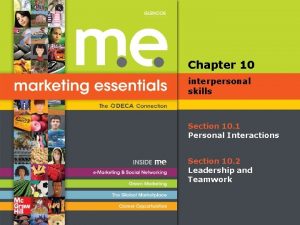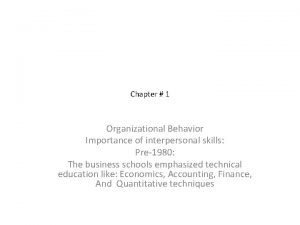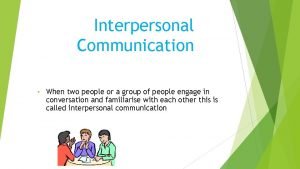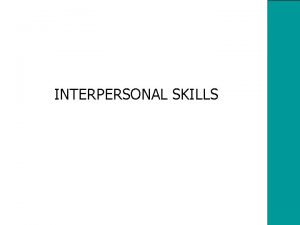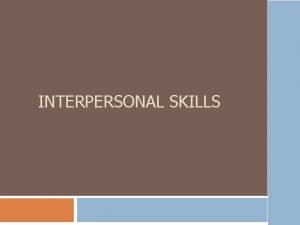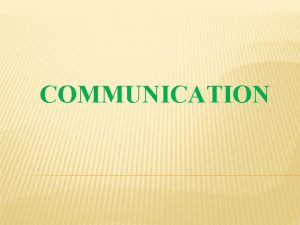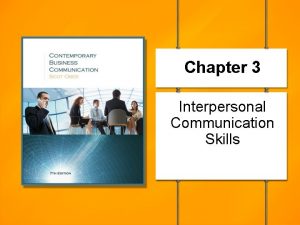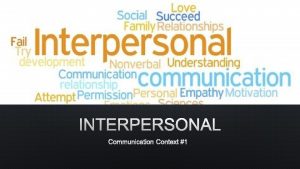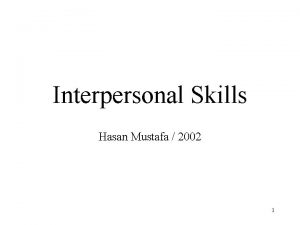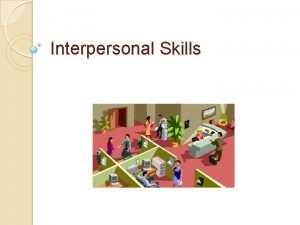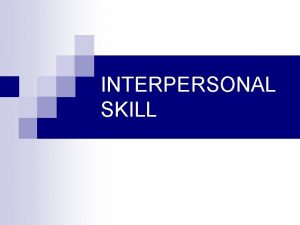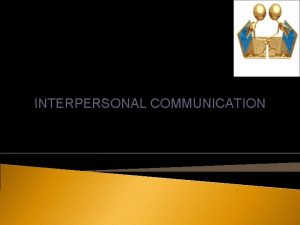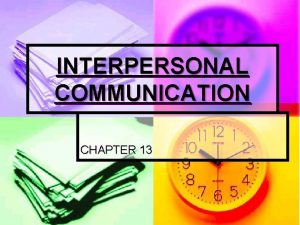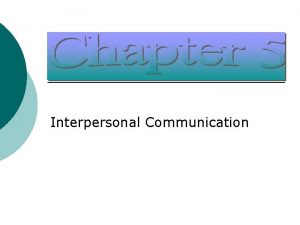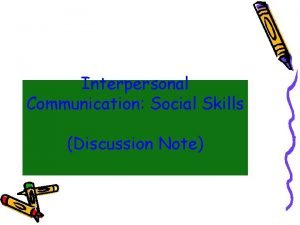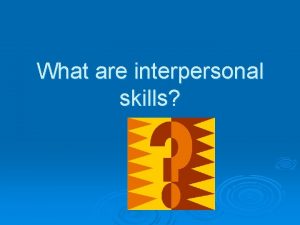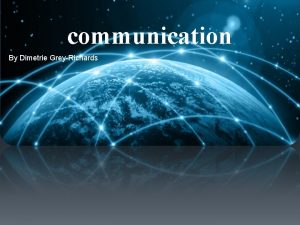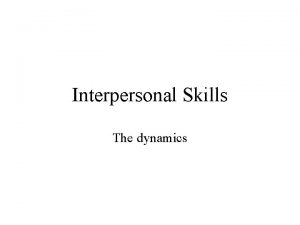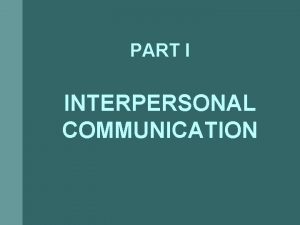Communication Skills 2016 Communication Everyone uses interpersonal communication

























- Slides: 25

Communication Skills 2016

Communication Everyone uses interpersonal communication skills. We use them at home with our families, in the workplace, in school, on our computers when we answer email, and on the telephone when we order pizza. This manual is intended to help you improve your interpersonal communication skills and develop new skills to become a more effective communicator. Interpersonal communication applies to all of our relationships, personal and business. Others respect or reject us based on our interpersonal communication skills. People send us messages in every interpersonal communication encounter. Those messages can be explicit (verbal comments) or implicit (nonverbal facial expressions, other body language, and physical space).

Communication Information transmitted • A verbal or nonverbal message • A process by which information is exchanged between individuals through a common system of symbols, signs, or behavior

Key elements • Your audience: In order to be an effective communicator, you need to know who your AUDIENCE is. • Your message: What do you want to say? What is the best way to communicate the message? There is a basic rule used by journalists for writing a newspaper story that can help you focus your message. A well-written story should contain the who, what, when, where, why, and how of the story in the first paragraph or two. If it does not, it will not hold our attention.

Five basic communication tools Ø Listening Ø Speaking Ø Reading Ø Writing Ø Body language

How we get and use information We lose 50 percent of what we see and hear immediately and another 25% within 48 hours

Blocks to effective communication Body language Not paying attention Message too difficult Not direct communication Hear only what you want to hear Too soft, not clearly enunciated, too fast, etc.

Body Language Our own behavior can affect those around us. We try to draw impressions of people, and they of us, by observing both their verbal and non-verbal behavior. We communicate a lot without saying a word. It is estimated that over 75 percent of the messages we deliver are communicated non-verbally.

Tips It is estimated that we use only about 25 percent of our listening capacity. Here are three tips to help you increase your ability to listen by 50 percent: Ø Look at the speaker (benefit = 15 percent) Ø Ask questions (benefit = 15 percent) Ø Take notes (benefit = 20 percent)

Improvement takes time… Improvement occurs only if you practice these good listening skills. Try one of them for about three months. It takes at least that long to create a new habit. If you are a good list taker already, then practice asking questions to clarify what you hear. Avoid trying to implement all three tips at the same time. Success with one new habit will encourage you to try others.

Other important skills Empathy Being able to put your thoughts into words Equality Openness Trust Practice good listening skills (remain silent if necessary) All communication depends on how it is interpreted!!!!

There are three basic ways to deal effectively in conflict situations: 1. Listen carefully to determine the nature of the conflict 2. Identify areas of agreement 3. Allow the other person a way out Direct your criticism at behavior, not the person Say something positive Identify behavior that can be fixed or changed Avoid use of the word “you” Avoid negative words like “no, not, never, shouldn’t” Offer specific ways to make changes in behavior (doable action)

Personal space ranges from 2 to 4 feet and is used among friends and family members, and to separate people waiting in lines at teller machines or fast food vendors for example.

How to read faces Brushing Hair Off Your Face This movement, a combination of nerves and flirtation, helps call attention to and frame your feminine assets (think face and neck). No wonder it’s a staple of a promising date. Smiling Botox be damned! The only real smile, says Anita Barbee, a professor of social work at the University of Louisville, in Kentucky, is one in which eye muscles are engaged. People who grin for more than five seconds and only with their lips can be faking it. Frequent smiling in the workplace can make a person seem less serious. Blinking The normal blink rate is six to eight times a minute. But under stress, you’ll blink more often and somewhat more dramatically. Want to know who’s freaking out and who’s as cool as a cucumber at the next big meeting? The eyes have it.

Nibbling Your Lips If you bite, suck on, or lick your lips when under pressure or in an awkward situation, you’re attempting to comfort or soothe yourself, says psychologist Carol Kinsey Goman. Scratching Your Nose Don’t get caught in a lie. “When a person fibs, it’s often accompanied by an adrenaline rush, ” says psychologist Michael Cunningham, a professor of communication at the University of Louisville. This release causes capillaries to expand, making the nose itch. Another tall-tale tell: a sustained glance. A liar often overcompensates for being perceived as shifty by focusing a bit too intently on the person he is fibbing to. Sending Darting Glances This catch-your-eye game, usually played in guy-girl situations, tends to mirror your scattered thoughts. Does he like me? Do I like him? Do I want him to come over here? Also, unlike a direct gaze, the back-and-forth variety is a protective measure: If he doesn’t approach you, you won’t feel rejected. Nodding Your Head If you nod in clusters of three, the speaker will sense your interest, and this can lengthen her response threefold, says Goman. Word to the wise: Nod only once when trying to escape Chatty Cathy.

Closing Your Eyes By rubbing, covering, or closing your eyes for longer than a blink, you’re trying to keep out certain auditory or visual cues. It’s a survival mechanism to prevent the brain from processing anything undesirable or threatening. Lowering Your Gaze This meek gesture is an unconscious bid for public support—a favorite tactic of small children, not to mention the late Princess Diana. It often elicits a parental response. If someone does it to you, she may be searching for your empathy. Be gentle. Pursing Your Lips Narrowing the red margins of your lips is a clear sign of anger, says Paul Ekman, professor emeritus at the University of California, San Francisco. Why? When a person is not truly mad, she typically can’t feign this gesture, even if she tries.

Tilting Your Head Cock your head to the side when hearing a friend’s sob story. This movement indicates that you’re interested and listening. On a more literal level, you’re revealing and angling your ear to her, physically showing that you want to hear every detail. Raising or Furrowing Your Eyebrows “Raised eyebrows, one or both, is a true expression of piqued curiosity and interest, while lowered eyebrows can indicate negative emotions, such as confusion and fear, ” says Laura Guerrero, a professor of communication at the Arizona State University Hugh Downs School of Human Communication, in Tempe. If you’re not interested in a good or bad way, your face will remain still and unanimated. Looking Up or to the Side Want a little glimpse into the way someone’s memory works? Notice where the person moves her eyes. When recalling something that was seen, a person will angle her eyes skyward, as if trying to picture it. When remembering something heard, she will look toward one of her ears, as if listening for it. Especially emotional experiences tend to be relived through introspective downward glances.

Body Language Standing With Legs Together This conservative stance denotes deference Angling Yourself Do you align yourself with the head honcho at work? Most people position their bodies or feet toward the person who has captured their focus. Coming to attention and squaring your chest at the sight of your boss is a sign of respect. Another note about proper alignment: If someone approaches you and a friend in the middle of a conversation and you want to give the newcomer a nonverbal invitation to join in, angle your bodies outward by 45 degrees. This subtle sign of inclusion shows the person that she is welcome.

Standing With Legs Apart This position, feet and legs shoulder-width apart, signals dominance and determination, says Goman. When asserting your side of an argument or discussion, stand your ground—literally. For an extra boost, place your hands on your hips. This is a traditional position of power. Leaning No surprise here: You lean toward people you like and pull away from those you don’t. On a date? Take note of your companion’s direction—and yours. Subtly mirroring movements builds trust.

Shifting Your Weight From Side to Side or Front to Back “The way you move your body reflects your attitude, ” says Goman. Constantly transferring your weight from one foot to the other or rocking forward and backward is a comforting movement that indicates you are anxious or upset. Basically, this is a physical representation of what is going on in your head: You are betwixt and between many unsettling thoughts and can’t stop moving from one to the other. Massaging Your Forehead or Earlobes These soothing actions counter feelings of uneasiness or vulnerability—for example, when you are seated in the front row of a lecture hall and hope not to be called on. The same goes for hugging your sides or rubbing your legs when you’re sitting. Stroking the nerve endings in some of these body parts helps lower blood pressure and heart rate.

Crossing Your Arms Don’t be too quick to leap to conclusions: This pose doesn’t always mean anger, but when coupled with crossed legs, it is a defensive position. Take note of the surroundings. More often than not, this stance means a person is cold. Also, many people simply find it comfortable, says Cunningham. Walking The way you tread speaks volumes about how others see you. Fast strutters come across as productive and competent, looking as if they have somewhere important to be. Those with a “bounce in their step” are perceived as having upbeat personalities. For a purposeful stride, walk from heel to toe. (Interestingly, most men land on their heels; most women, mid-arch. ) Sitting When in doubt, spread out. Taking up space, such as by fanning out your papers in the boardroom instead of stacking them in a small pile, screams importance. Likewise, sitting with your legs apart assures others that you are large and in charge.

How to read hands Opening Up Your Hands By spreading your hands as if serving someone a treat off a tray, you are indicating that you are open to new ideas being offered. Facing your palms down or clenching your fists shows you have a strong position—one that may not be so flexible. Flailing Your Arms You’re not out of control. Research shows that those who gesture when they speak seem energetic, agreeable, and warm, while those who gesticulate less are seen as logical and analytic. Keep in mind that moderation is key; overly animated gestures that border on frantic make you appear unbelievable and less powerful. If you fear you may be too animated, perhaps in a job interview, hold on to something when you talk.

Hiding Your Hands Stashing your hands in your lap, stuffing them in your pockets, and holding them behind your back are movements of deceit—you’re hiding something. “A person may be telling you one thing, but these cues indicate you’re not getting the whole story, ” says Barbee. Picking at Your Nails Messing with cuticles is a sign of low confidence and timidity. Try steepling your fingers (hands folded together with index fingers extended) so you can’t pick and you instead appear self-assured.

How to read feet Pointing Toes In Even if you’re sitting up straight with your shoulders aligned and your head up—all signs of an open body position—your feet may be betraying you. If they’re cocked inward, big toe to big toe, this indicates that you’re closing yourself off because you feel awkward or insecure. Fidgeting Ever notice that you become more physically active—you tap your heels, slide in and out of your shoes, bop your foot up and down while crossing your legs—the more uncomfortable you feel? This is because these kinds of moves relieve tension. Fidgeting may also mean that you want out of a situation and your body is getting ready to take flight. The bottom line? At least in professional settings, cross your ankles to calm those fidgety feet.

Crossing Your Legs Pay attention to the direction in which you cross your legs. In a seated conversation, people tend to point the toes of the top leg toward the person who they feel is the most approachable. The kicker? Lifting your toes means your feelings toward said person are extra-positive. Pointing Toes Toward the Door When you’re having a conversation with someone but her feet are angled toward the door, she may be unconsciously saying that she’s ready to cut the talk short and move on.
 Intra vs interpersonal skills
Intra vs interpersonal skills Hello everyone i hope you are doing well
Hello everyone i hope you are doing well Mastering team skills and interpersonal communication
Mastering team skills and interpersonal communication Communication english skills
Communication english skills Communication and interpersonal skills
Communication and interpersonal skills Module 3 communication/interpersonal skills
Module 3 communication/interpersonal skills Communication and interpersonal skills cv
Communication and interpersonal skills cv Examples of supportive communication
Examples of supportive communication Interpersonal skills in social work
Interpersonal skills in social work Interpersonal skills in business communication
Interpersonal skills in business communication Intrapersonal communication vs interpersonal communication
Intrapersonal communication vs interpersonal communication Interpersonal skills wiki
Interpersonal skills wiki Interpersonal vs intrapersonal
Interpersonal vs intrapersonal Soft skills training ppt
Soft skills training ppt Interpersonal conflict resolution skills
Interpersonal conflict resolution skills Interpersonal communication barriers
Interpersonal communication barriers Factors affecting interpersonal skills
Factors affecting interpersonal skills Interpersonal skills opposite
Interpersonal skills opposite 10 interpersonal skills
10 interpersonal skills Interpersonal skills of system analyst
Interpersonal skills of system analyst Characteristics of interpersonal
Characteristics of interpersonal 6 interpersonal skills
6 interpersonal skills Organizational and interpersonal skills
Organizational and interpersonal skills Interpersonal skills in marketing
Interpersonal skills in marketing How to pronounce interpersonal skills
How to pronounce interpersonal skills Interpersonal skills of system analyst
Interpersonal skills of system analyst


